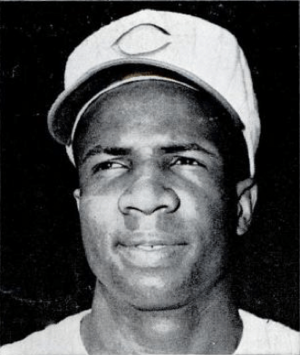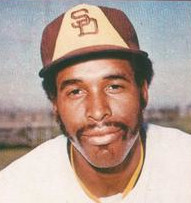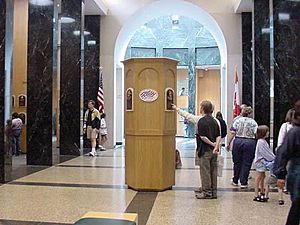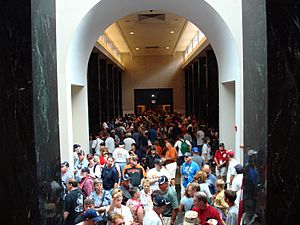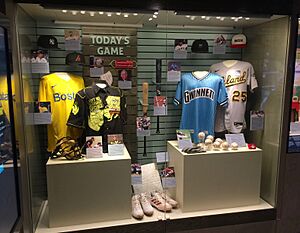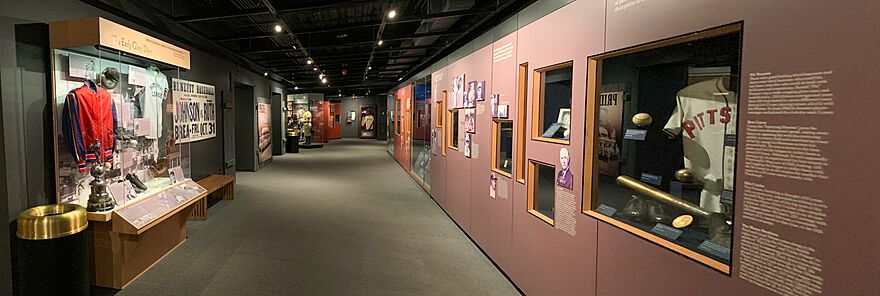National Baseball Hall of Fame and Museum facts for kids
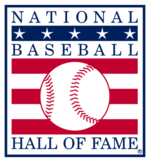 |
|
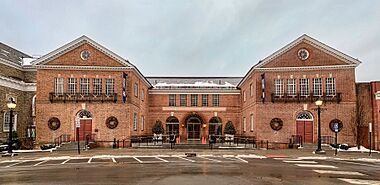
The Hall of Fame in 2020
|
|
| Established | 1936 (Baseball) Dedicated June 12, 1939 |
|---|---|
| Location | Cooperstown, New York, U.S. |
| Type | Professional sports hall of fame |
| Key holdings |
|
| Collections |
|
| Collection size |
|
| Visitors | 260,000/year (average as of 2018) |
| Founder | Stephen Carlton Clark |
The National Baseball Hall of Fame and Museum is a special place in Cooperstown, New York. It's a history museum and a hall of fame all in one. This museum collects and displays amazing baseball items. It also honors people who were excellent players, managers, or helped the sport grow.
The Hall's main goal is "Preserving History, Honoring Excellence, Connecting Generations." When people say "Cooperstown," they often mean the National Baseball Hall of Fame. The museum also decides who gets into the Hall of Fame.
Stephen Carlton Clark started the Hall of Fame in 1939. He wanted to bring more visitors to Cooperstown. The town was struggling because of the Great Depression and Prohibition. Clark built the Hall of Fame building, which opened on June 12, 1939. There was a popular story that Abner Doubleday invented baseball in Cooperstown. This story helped make Cooperstown the perfect spot for the Hall.
In 1994, a bigger library and research center opened. The Hall also created a traveling exhibit called Baseball as America in 2002. It visited ten museums across the U.S. The Hall of Fame now offers online programs for students. This helps kids learn about baseball history even if they can't visit.
Contents
Baseball Hall of Fame Inductees
When baseball fans talk about the "Hall of Fame," they mean two things. They mean the museum in Cooperstown, New York. They also mean the special group of players, managers, umpires, and others who have been chosen for the Hall.
The first five people chosen in 1936 were Ty Cobb, Babe Ruth, Honus Wagner, Christy Mathewson, and Walter Johnson. About 20 more were picked before the Hall opened in 1939. As of January 2025, 351 people have been elected. This includes 278 former players, 23 managers, 10 umpires, and 40 pioneers or executives.
Many members (119) were inducted after they had passed away. This includes 31 members from the Negro leagues. The Hall of Fame also includes one woman, baseball executive Effa Manley.
The newest members of the Hall of Fame, as of January 21, 2025, are Dick Allen, Dave Parker, CC Sabathia, Ichiro Suzuki, and Billy Wagner.
In 2019, Mariano Rivera became the first player chosen by every writer. Derek Jeter, Marvin Miller, Ted Simmons, and Larry Walker were inducted on September 8, 2021. Their ceremony was delayed due to the COVID-19 pandemic.
How Players Are Chosen

Players can be chosen for the Hall of Fame in two main ways. One way is by the Baseball Writers' Association of America (BBWAA). The other way is by the Veterans Committee.
To be considered by the BBWAA, a player must have played for at least 10 years in the major leagues. They must also have been retired for five years. A special committee checks if players meet the basic requirements. Writers who have covered MLB for at least 10 years can vote. Each writer can vote for up to 10 players.
A player needs to be named on 75% or more of the ballots to be elected. If a player gets less than 5% of the votes, they are removed from future BBWAA elections. Players who get 5% or more but less than 75% can be considered for up to ten years.
Sometimes, players can be chosen even if they don't meet all the usual rules. For example, Addie Joss was elected in 1978. He only played nine seasons before he passed away. If a player passes away before their five-year waiting period, they can be put on the ballot sooner. Roberto Clemente was inducted in 1973, shortly after his death.
The five-year waiting period started in 1954. Before that, the rules were different. For example, Joe DiMaggio was elected just four years after he retired.

There's a common misunderstanding about Lou Gehrig's election. He was eligible under the rules at the time. However, the BBWAA held a special election for him in 1939. This was likely because he was very ill. This special election allowed him to enter the Hall while he was still alive.
If a player isn't elected by the BBWAA within 10 years, the Veterans Committee can consider them. This committee also considers managers, umpires, and executives.
Players from the Negro leagues have also been considered. In 2005, the Hall studied African American players from the late 1800s to 1947. In February 2006, a special election chose seventeen figures from the Negro leagues. This was in addition to eighteen chosen earlier.
Baseball fans often debate who should or shouldn't be in the Hall of Fame. It's a big part of being a baseball fan!
Players Not Inducted Due to Bans

The Hall of Fame rules prevent anyone on baseball's "permanently ineligible" list from being inducted. Two famous players affected by this rule were Pete Rose and Shoeless Joe Jackson. Both were banned from MLB for life because of gambling on games involving their own teams.
Jackson was involved in the 1919 World Series scandal. He was accused of helping to lose games on purpose and taking money for it. This led to baseball's Rule 21. This rule says that anyone who bets on a game they are involved in (as a player, manager, or umpire) is banned for life.
Rose accepted a permanent ban in the 1980s. This was because of claims he bet on the Cincinnati Reds when he was their manager. Even though there was no proof he bet against his team, betting on his own team was a clear violation of Rule 21. Rose later admitted in his 2004 book that he had bet on the Reds.
Before the ban was lifted in 2025, fans had strong opinions about whether Rose and Jackson should be allowed into the Hall.
Choosing a Team for the Plaque
When a player or manager is inducted, their plaque lists all the teams they played for. However, they are usually shown wearing the cap of one specific team. The Hall chooses this team based on where the person made their biggest impact.
Sometimes, inductees played for many teams. Here are some examples:
- Frank Robinson: He chose the Baltimore Orioles cap. He played 10 seasons with the Cincinnati Reds and 6 with Baltimore. He won two World Series with the Orioles.
- Catfish Hunter: He chose not to have any team logo on his cap. He played for both the Kansas City/Oakland Athletics and the New York Yankees. He had success with both and didn't want to pick one over the other.
- Nolan Ryan: He chose the Texas Rangers cap. He spent 5 seasons with the Rangers, 9 with the Houston Astros, and 8 with the California Angels. He chose the Rangers because he finished his career there and achieved big milestones.
- Reggie Jackson: He chose the Yankees cap. He played 10 seasons with the Oakland A's, winning three World Series. He played 5 years with the Yankees, winning two World Series. He earned his nickname "Mr. October" with the Yankees.
- Carlton Fisk: He chose the Boston Red Sox cap. He played longer with the Chicago White Sox. But he is most famous for his "Stay fair!" home run with the Red Sox in the 1975 World Series.
- Sparky Anderson: He chose the Cincinnati Reds cap. He managed the Detroit Tigers for almost twice as long. He chose the Reds to honor the general manager who gave him his first major-league managing job.
- Dave Winfield: He chose the San Diego Padres cap. He spent the most years with the Yankees. But he chose the Padres due to disagreements with the Yankees owner.

In 2001, the Hall of Fame changed its policy. They decided they would make the final decision on the cap logo. They would still consider the player's wishes. This change happened because of rumors that teams were offering money or jobs for players to pick their cap.
Here are some players affected by the new policy:
- Gary Carter: He wanted a Mets cap, but the Hall chose an Montreal Expos cap. He played 12 years with the Expos and 5 with the Mets.
- Wade Boggs: He was shown with a Boston Red Sox cap. He played 11 years with the Red Sox and 5 with the Yankees.
- Andre Dawson: His cap shows him as an Expos member. He played 11 years with the Expos, but preferred the Chicago Cubs.
- Tony La Russa: He chose not to have a logo. He managed three teams: the Chicago White Sox, Oakland Athletics, and St. Louis Cardinals. He felt his induction was for all three teams.
- Greg Maddux: He chose not to have a logo. He had great success with the Atlanta Braves (11 seasons) and played 10 seasons with the Chicago Cubs. He felt both fanbases were important.
- Randy Johnson: He chose a Arizona Diamondbacks logo. He played for six teams. He had more major awards and his only title with the Diamondbacks.
- Vladimir Guerrero: He chose an Angels logo. He played most of his career with the Montreal Expos. However, he had more success and awards with the Angels.
- Mike Mussina: He chose no logo. He played 10 seasons with the Baltimore Orioles and 8 with the New York Yankees. He felt he couldn't pick one team.
- Roy Halladay: He was elected in 2019 after he passed away. He played 12 seasons with the Toronto Blue Jays and 4 with the Philadelphia Phillies. His family chose not to have a logo on his cap.
The Museum Experience
The idea for a Baseball Hall of Fame started with Sam Crane in the early 1900s. But it didn't gain much support until later. In 1934, the idea was revived by people like Ford C. Frick, president of the National League. Stephen Carlton Clark paid for the museum's construction. It was planned to open in 1939 for baseball's "Centennial."
The Hall of Fame says about 260,000 people visit each year. Over 17 million people have visited in total. Visitors see only a small part of the museum's huge collection. It has 40,000 artifacts, 3 million library items (like photos), and 140,000 baseball cards.
The museum has seen fewer visitors since the mid-2010s. One reason might be Cooperstown Dreams Park. This youth baseball complex is about 5 miles away. It brings 17,000 young players each summer. While players stay at the park, their families stay elsewhere. This means families might only visit the Hall of Fame once during their trip.
First Floor Highlights
- Baseball at the Movies shows items from baseball films. A screen plays clips from these movies.
- The Bullpen Theater hosts daily events like trivia games. It's decorated with pictures of famous relief pitchers.
- Inductee Row displays pictures of Hall of Famers from 1937 to 1939.
- The Perez-Steele Art Gallery features baseball art in many styles.
- The Plaque Gallery is the most famous part of the museum. It holds the plaques of all Hall of Fame members.
- The Sandlot Kids Clubhouse has fun, interactive displays for younger children.
- A theater area continuously plays the funny "Who's on First?" routine by Abbott and Costello.
- Scribes and Mikemen honors baseball writers and broadcasters. It has photos and items related to their work. Outside, there are statues of Johnny Podres, Roy Campanella, and an All-American Girls Professional Baseball League player. A Satchel Paige statue was added in 2006.
- An Education Gallery hosts school groups. In summer, it has presentations about items from the museum's collection.
Second Floor Highlights
- The Grandstand Theater shows a 12-minute multimedia film. This 200-seat theater looks like old Comiskey Park.
- The Game is the main exhibit on this floor. It displays the most artifacts. It's set up like a timeline, showing baseball's history from its start to today.
- Taking The Field covers 19th-century baseball.
- Babe Ruth: His Life and Legend focuses on the famous player.
- The Souls of the Game: Voices of Black Baseball tells the story of Black baseball players.
- Diamond Dreams celebrates women in baseball.
- ¡Viva Baseball! is a bilingual exhibit about baseball in Latin America.
- Whole New Ballgame opened in 2015. It continues the baseball timeline up to the modern game. It has video walls and interactive displays with artifacts.
- The Today's Game exhibit shows items recently given to the Hall of Fame.
Third Floor Highlights
- Autumn Glory is all about post-season baseball. It has a display of World Series rings from different years.
- Hank Aaron: Chasing the Dream is an exhibit about the legendary player.
- One for the Books tells the story of baseball's most important records. It has over 200 artifacts. Fans can search records using an interactive "Top Ten Tower."
- BBWAA awards: Replicas of awards given each season, with lists of past winners.
- A display about Ichiro Suzuki's record for hits in a single season (262 in 2004).
- An inductee database computer with stats for every Hall of Famer.
- Programs from every World Series.
- Sacred Ground focuses on baseball parks. It covers the fan experience and the business side of ballparks. A computer tour lets visitors explore old ballparks like Boston's South End Grounds.
- The Your Team Today exhibit looks like a baseball clubhouse. It has 30 locker stalls, one for each Major League team. Each stall has a jersey and other items from the team, plus a short team history.
Other Notable Events
Commemorative Coins
In 2012, a law was passed to create special coins for the Hall of Fame. The United States Mint made and sold these coins. They show baseball gloves and balls. These were the first curved coins made by the Mint. The coins included gold, silver, and clad (nickel-copper) versions. They were released on March 27, 2014, and the gold and silver coins sold out quickly. The Hall receives money from the sale of these coins.
See also
 In Spanish: Salón de la Fama del Béisbol para niños
In Spanish: Salón de la Fama del Béisbol para niños
- All-American Girls Professional Baseball League § National Women's Baseball Hall of Fame inductees
- Award share
- Baseball awards § United States
- Bob Feller Act of Valor Award
- Honor Rolls of Baseball (1946) (managers, executives, writers, umpires)
- List of Major League Baseball awards
- List of members of the National Baseball Hall of Fame
- Negro Leagues Baseball Museum
- Nisei Baseball Research Project


